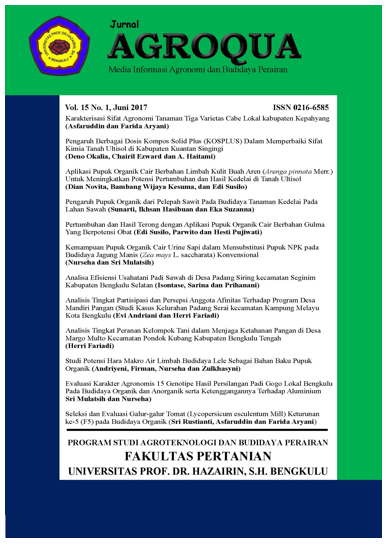PENGARUH KOMPOSISI MEDIA TANAM DAN DOSIS PUPUK NPK TERHADAP PERTUMBUHAN DAN HASIL BAWANG MERAH (Allium ascalonicum L.)
DOI:
https://doi.org/10.32663/ja.v20i2.3197Keywords:
NPK fertilizer, planting medium, shallotAbstract
This study aims to determine the effect of the composition of the planting media and the dose of NPK fertilizer on the growth and yield of shallots. This study was conducted in Rawa Makmur village of Bengkulu from December 2021 to March 2022. The design used was a completely randomized design (CRD) with 2 (two) treatments and three replications. The first treatment was the composition of the planting media, which consists of three levels, topsoil + manure (1:2), topsoil + rice husk (1:2) and topsoil + manure + rice husk (1:1:1). The second treatment was the dose of NPK fertilizer, which consists of three levels, 200 kg/ha, 250 kg/ha and 300 kg/ha. The results of the analysis of variance were continued with the Duncan's Multiple Range Test (DMRT) test with a test level of 5%. The results showed that the composition of the planting media had a very significant effect on the growth and yield of shallots except for variable the number of leaves 2 wap and the number of tillers per polybag. The best planting media composition treatment for the growth and yield of shallots was topsoil soil + manure (1:2). The treatment dose of NPK fertilizer significantly affected the number of leaves 6 wap. The best dose of NPK fertilizer for the growth of shallots was a dose of 300 kg/ha, with the highest number of leaves at 6 wap. The interaction of the treatment composition of the planting media and the dose of NPK fertilizer had no significant effect on the growth and yield of shallots.
References
Downloads
Published
Issue
Section
License
Authors who publish with this journal agree to the following terms:
- Authors grant the journal right of first publication with the work simultaneously licensed under a Creative Commons Attribution 4.0 Internasional (CC BY 4.0) Licence that allows others to use and share the work with an acknowledgment of the work's authorship and initial publication in this journal.
- The author(s) still hold the copyright of his/her/their work and retain publishing rights without restrictions such as (but not limited to) patent right, lecture, book and reproduce the article for own purposes.
















